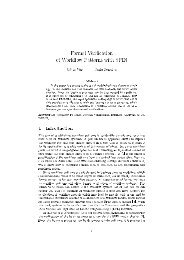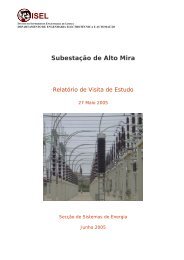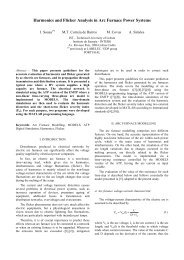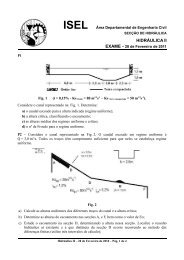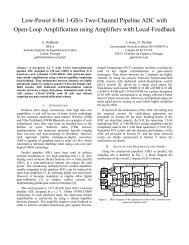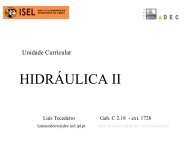Low-Power Open Loop Multiply-by-two Amplifier with Gain-accuracy ...
Low-Power Open Loop Multiply-by-two Amplifier with Gain-accuracy ...
Low-Power Open Loop Multiply-by-two Amplifier with Gain-accuracy ...
You also want an ePaper? Increase the reach of your titles
YUMPU automatically turns print PDFs into web optimized ePapers that Google loves.
<strong>Low</strong>-<strong>Power</strong> <strong>Open</strong> <strong>Loop</strong> <strong>Multiply</strong>-<strong>by</strong>-<strong>two</strong> <strong>Amplifier</strong><br />
<strong>with</strong> <strong>Gain</strong>-<strong>accuracy</strong> Improved <strong>by</strong> Local-Feedback<br />
1 DEE/FCT-UNL – CTS/UNINOVA<br />
Universidade Nova de Lisboa<br />
Monte da Caparica, Portugal<br />
jg@uninova.pt<br />
R. Gama 1, 2 , A. Galhardo 3, 1 , J. Goes 1 , N. Paulino 1 , R. Neves 2 and N. Horta 2<br />
2<br />
Instituto de Telecomunicações<br />
Instituto Superior Técnico<br />
Lisboa, Portugal<br />
rui.neves@tagus.ist.utl.pt<br />
3<br />
DEEA - Instituto Superior de<br />
Engenharia de Lisboa<br />
Lisboa, Portugal<br />
galhardo@deea.isel.ipl.pt<br />
Abstract—This paper proposes the complete electrical design<br />
of a new multiply-<strong>by</strong>-<strong>two</strong> amplifier to be readily used in ultra<br />
high-speed medium resolution pipeline ADC stages. It is based in<br />
a switched-capacitor open-loop structure but <strong>with</strong> the novelty of<br />
having the gain <strong>accuracy</strong> improved <strong>by</strong> using an active amplifier<br />
<strong>with</strong> local feedback. Simulation results demonstrate that, <strong>with</strong> a<br />
very low-power dissipation and <strong>with</strong>out employing any digital<br />
self-calibration or gain-control techniques, the circuit exhibits,<br />
over PVT corner and device mismatches, a dynamic performance<br />
and a gain-<strong>accuracy</strong> compatible <strong>with</strong> 6-bit level.<br />
Index Terms—ADC; multiply-<strong>by</strong>-<strong>two</strong>; low-power; timeinterleaved;<br />
gain-<strong>accuracy</strong><br />
I. INTRODUCTION<br />
Wireless short range connectivity <strong>with</strong> high data rate<br />
capabilities, is and will be one of major driven technology for<br />
the consumer electronics mass market. Wireless (USB) and<br />
Ultra Wideband (UWB) Bluetooth are examples of such<br />
technologies since they start from an installed base in the<br />
billions of ports. Software radio UWB receiver<br />
implementation has numerous potential benefits ranging from<br />
low-cost and ease-of-design to flexibility. However such<br />
approach implies analogue-to-digital converters (ADCs)<br />
capable of sampling rates in order of GS/s, which constitutes a<br />
technical challenge when using a low-cost pure digital CMOS<br />
technology.<br />
Parallel pipeline ADCs have been used to achieve medium<br />
resolutions at very high sampling rates [1, 2]. Also sharing<br />
some common blocks between <strong>two</strong> or more parallel ADCs, in<br />
a time-interleaved fashion can reduce the total power. The<br />
closed-loop multiply-<strong>by</strong>-<strong>two</strong> residue amplifiers (MBTA)<br />
usually integrated in the pipeline ADCs can be replaced <strong>by</strong><br />
open-loop amplifiers [3, 4], reducing global size and power.<br />
However, it becomes mandatory to employ either digital gaincalibration<br />
[3] or employ replica circuits for implementing<br />
global-gain control techniques [4].<br />
This work presents the complete design, in a 1.2 V 130 nm<br />
1P-8M CMOS technology, of a time-interleaved MBTA<br />
This work was partially supported <strong>by</strong> the Portuguese Foundation for<br />
Science and Technology (FCT/MCTES) under LEADER (PTDC/EEA-<br />
ELC/69791/2006), SPEED (PTDC/EEA-ELC/66857/2006) and IMPACT<br />
(PTDC/EEA-ELC/101421/2008) projects.<br />
building block targeting high-speed, medium/low resolution<br />
pipeline ADCs. Although open-loop residue amplification is<br />
performed, the proposed amplifier employs local-feedback in<br />
order to achieve constant closed-loop gain against Process-<br />
Supply-Temperature (PVT) variations and thus, avoiding the<br />
need of any digital self-calibration or gain-control techniques.<br />
Simulated results demonstrate that, <strong>with</strong> a power<br />
dissipation as low as 2.0 mW, the dynamic performance of the<br />
circuit operating at 200 MS/s is compatible <strong>with</strong> more than 6<br />
bits and very robust against PVT variations and device<br />
mismatches.<br />
In Section II a description of the complete open-loop<br />
switched-capacitor (SC) time-interleaved MBTA circuit is<br />
presented and, in Section III, the transistor-level<br />
implementation of the closed-loop active amplifier is<br />
described in detail. Simulated results of dynamic performance<br />
of proposed MBTA circuit are provided in Section IV, and the<br />
main achieved results are finally summarized in Section V<br />
where the main conclusions are drawn.<br />
II. CIRCUIT ARCHITECTURE<br />
Figure 1 shows the circuit schematic of a SC open-loop<br />
MBTA. The circuit is an important building block in a time<br />
interleaved pipeline ADC. As illustrated in Figure 1 the<br />
amplifier is shared between <strong>two</strong> channels.<br />
The circuit operates as follows. During phase Φ 1 , channel<br />
1 samples the input voltage v ip into sampling capacitors C Si .<br />
For a direct application in a 6-bit pipeline ADC (targeting 5.5-<br />
bit ENOB), the capacitance value of the four unit capacitors<br />
C Si is set to 300 fF in order to set the thermal noise one bit<br />
below the quantization noise and also to deal <strong>with</strong> a 6 ps clock<br />
jitter (assuming that the clock is provided <strong>by</strong> a feasible PLL).<br />
In phase Φ 2 , the sampled signal is amplified <strong>by</strong> a gain of 2 and<br />
the output signal is produced according to<br />
v od = v op − v on = −2 ⋅ v id (1)<br />
where v id = v ip − v in . Channel 2 operates in opposite phases.<br />
The negative reference V REFN is set to 0.3 V and the<br />
common-mode voltage, V CM , to 0.55 V. Switches connected<br />
to the amplifier input signals are implemented <strong>with</strong>
asymmetrical transmission-gates (ATG) employing bulkswitching,<br />
switches connected to the reference voltage V REFN<br />
are simply NMOS transistors and all remaining switches are<br />
implemented using symmetrical transmission gates (STG).<br />
v ip<br />
v in<br />
V CM<br />
V REFN<br />
Φ 2<br />
Φ<br />
C 1Φ2<br />
Φ 1 S1<br />
Φ 1<br />
Φ 2<br />
Φ 2<br />
C S1 Φ 1 in<br />
V V p + +<br />
CM REFN<br />
<strong>Amplifier</strong><br />
V V G=2<br />
CM REFN<br />
_ _<br />
Φ 1<br />
Φ in<br />
C 2 n<br />
S2<br />
Φ 2<br />
Φ 1<br />
Φ 2 C<br />
Φ<br />
Φ 1<br />
1<br />
S2 Φ2<br />
v op<br />
v on<br />
V REFP<br />
/2<br />
V REFN<br />
/2<br />
V CM<br />
X<br />
Y<br />
Z<br />
V REFN<br />
Φ Φ 1<br />
n1<br />
Φ n1<br />
C Sp<br />
Φ 1 in v op<br />
v p<br />
ip +<br />
G=2<br />
v _<br />
in<br />
Φ n1<br />
Φ<br />
C 1 in v<br />
Sn<br />
n<br />
on<br />
X<br />
Φ 1<br />
Φ n1<br />
V REFN<br />
/2<br />
Y<br />
V REFP<br />
/2<br />
Z V REFN<br />
V CM<br />
v in<br />
Figure 2. Modified 1.5-bit MDAC circuit.<br />
+<br />
_<br />
G=2<br />
v out<br />
V CM<br />
V REFN<br />
Figure 1. Schematic of the proposed open-loop time-interleaved multiply-<strong>by</strong><strong>two</strong><br />
amplifier using a closed-loop active amplifier.<br />
Note that to be readily used in pipeline ADCs, the<br />
proposed MBTA has to be slightly modified (adding 8<br />
additional switches) into a multiplying digital-to-analogue<br />
converter (MDAC). However, this modification is relatively<br />
straightforward for implementing a 1.5-bit MDAC since the<br />
only difference is that the bottom plates of the sampling<br />
capacitors have to be connected during phase Φ 2 , in the<br />
positive signal paths either to V REFN 2 , V REFP 2 or to<br />
VCM<br />
depending on the X, Y, Z digital code provided <strong>by</strong> the<br />
local 1.5-bit flash quantizer (see 0Figure 2). Likewise, the<br />
bottom plates of the sampling capacitors have to be connected<br />
during phase Φ 2 , in the negative signal paths either to<br />
V REFP 2 , V REFN 2 or to VCM<br />
depending on the same X, Y, Z<br />
digital code. As a consequence of this circuit modification, at<br />
the end of phase Φ 2 the differential output signal will be<br />
given <strong>by</strong><br />
⎛ X ⋅VREFD<br />
Y ⋅VREFD<br />
⎞<br />
v od = vop<br />
− von<br />
= −2⋅⎜vid<br />
− + ⎟ (2)<br />
⎝ 2 2 ⎠<br />
where VREFD<br />
= VREFP<br />
−VREFN<br />
. For a full-scale differential<br />
signal swing of 1 Vp-p, a V REFP equal to 0.8 V should be<br />
employed setting V REFP 2 and VREFN<br />
2 respectively to 0.675<br />
V and 0.425 V.<br />
As a practical example of using an MDAC circuit, the<br />
basic block of one 1.5-bit stage of a pipelined A/D converter is<br />
shown in Figure 3. The local ADC samples the input voltage,<br />
and quantizes it in a <strong>two</strong> bit code. The MDAC reconstructs<br />
that code into a voltage, which is subtracted from the sampled<br />
input voltage. The residue obtained is then amplified and<br />
delivered to the next stage as v = v − v .<br />
od<br />
op<br />
on<br />
ADC<br />
DAC<br />
2 bit MDAC<br />
Figure 3. Generic 1.5 (or 2) bit pipelined converter stage.<br />
<strong>Open</strong>-loop structures in pipelined A/D converters have<br />
widely been used and their main advantages are pointed out in<br />
[5]-[8]. One possible implementation when an open-loop<br />
structure is used is shown in Figure 4. Notice that, in this case,<br />
there is no feedback capacitor. Then, the amplifier gain is<br />
settled internally to 2.<br />
The quantizer code D i controls the reference level to be<br />
selected. Since that reference level is also amplified, the<br />
reference voltages need to be previously divided <strong>by</strong> 2.<br />
Capacitor C S stays charged during amplification, not being the<br />
charge redistributed onto any feedback capacitor as in the<br />
closed-loop schemes, and imposes to the amplifier input an<br />
inverted signal. This is corrected inverting also the amplifier<br />
gain, to −2. During phase Φ 2 , the input signal, v in , is applied to<br />
the local sub ADC input, <strong>with</strong> threshold values at +V REF /4 and<br />
−V REF /4, and C S is charged. During the next phase Φ 1 , C S is<br />
switched to the adequate reference voltage, according to<br />
previously stored quantizer outputs, D i , and the amplifier<br />
processes the signal presented at its input, delivering to the next<br />
stage the produced residue.<br />
The high gain requirement is avoided and a light and<br />
simple amplifier topology can be used, improving power<br />
efficiency, stability and allowed sampling rate. Another main<br />
advantage relies on the fact that a single sampling capacitor is<br />
required to implement both, sampling and DAC functions. As a<br />
consequence, the kT/C noise of this circuit is smaller when<br />
compared <strong>with</strong> the closed-loop approach.
v in<br />
2<br />
C S<br />
1 2<br />
_<br />
G=−2<br />
+<br />
v out<br />
currents are mirrored and the output currents can be higher, or<br />
the output levels easily changed.<br />
R Ln<br />
I<br />
R Dn<br />
R Dp<br />
I<br />
R Lp<br />
v outn<br />
v inn<br />
M 1<br />
M 2<br />
vinp<br />
v outp<br />
MUX<br />
-V REF<br />
/2<br />
0<br />
+V REF<br />
/2<br />
M 3<br />
M 4<br />
ADC<br />
D i<br />
Figure 4. <strong>Open</strong>-<strong>Loop</strong> structured stage.<br />
MDAC<br />
In other words, for the same amount of noise generated <strong>by</strong><br />
a given stage, the capacitance value adopted can be smaller for<br />
the open-loop approach, resulting in significant power savings.<br />
However, some challenging effects are introduced in open-loop<br />
solutions. Moreover, either self-calibration or servo-loop<br />
techniques have to be used to linearize the gain.<br />
III. AMPLIFIER IMPLEMENTATION<br />
A standard topology for a differential programmable gain<br />
or variable gain amplifier is shown in Figure 5. It is a circuit<br />
<strong>with</strong> a degenerated differential pair <strong>with</strong> a resistor as load. The<br />
differential input voltage, v id = v inp − v inn , causes a current flow<br />
in the degeneration resistors, R Dp = R Dn , a function of the sum<br />
of these and of the <strong>two</strong> transistors transconductance, g m .<br />
Figure 6. <strong>Amplifier</strong> <strong>with</strong> mirrored current.<br />
The input transistors, M 1 and M 2 , are still driving the current<br />
flowing in the degeneration resistors. The introduction of <strong>two</strong><br />
current sources and <strong>two</strong> other transistors, M 5 and M 6 , acting<br />
together <strong>with</strong> the input transistors, M 1 and M 2 , as <strong>two</strong> super<br />
(enhanced) source followers [70][71], can be seen in Figure 7.<br />
The input transistors, M 1 and M 2 , are forced to conduct a static<br />
current defined <strong>by</strong> the current sources shown hereunder. The<br />
transistors M 5 and M 6 conduct the difference of the currents<br />
defined <strong>by</strong> the upper and lower current sources. Also they take<br />
care of the current flowing through the degeneration resistors, a<br />
function of the differential input voltage. That current can be<br />
mirrored to M 3 and M 4 , and to the load resistors. The<br />
performance of this amplifier circuit is suitable, for example,<br />
for multiply-<strong>by</strong>-<strong>two</strong> stages in 10-bit A/D converters [10][11].<br />
R Ln<br />
I<br />
R Dn<br />
R Dp<br />
I<br />
R Lp<br />
I<br />
R Dn<br />
R Dp<br />
I<br />
v outn<br />
v inn<br />
M 1<br />
M 2<br />
vinp<br />
v outp<br />
v inn<br />
M 1<br />
M 2<br />
v inp<br />
v outp<br />
M 3 M 5<br />
M 6<br />
M 4<br />
v outn<br />
R Ln<br />
R Lp<br />
Figure 5. Degenerated differential pair amplifier (no local feedback).<br />
Figure 7. <strong>Amplifier</strong> <strong>with</strong> super-source followers.<br />
The output voltage, v od = v outp – v outn , is a function of the<br />
difference of the current flowing in load resistors, R Lp = R Ln ,<br />
and then it can be expressed <strong>by</strong> function (3), where<br />
R D = R Dp = R Dn and R L = R Lp = R Ln .<br />
v outn<br />
I<br />
R Fn<br />
v inn<br />
M 1<br />
I<br />
R Dn<br />
V CM<br />
R Dp<br />
I<br />
R Fp<br />
vinp<br />
I<br />
v outp<br />
v<br />
R<br />
L<br />
od<br />
= −vid<br />
(3)<br />
RL<br />
+1 gm<br />
The major advantage of this open-loop architecture relies on<br />
the fact that it is easy to change the overall gain, <strong>by</strong> changing<br />
the ratios of the load and degeneration resistors, making this<br />
circuit suitable for use as variable or programmable gain<br />
amplifier. Due to noise requirements, the resistance values<br />
have to be small, and to maintain the distortion levels low, the<br />
bias current needs to be large enough. An improvement [9] is<br />
the circuit shown in Figure 6 allowing a larger output swing<br />
and reduced bias current of the input transistor. The output<br />
M 3<br />
M 2<br />
M 4<br />
Figure 8. <strong>Amplifier</strong> <strong>with</strong> internal (local) feedback.<br />
The circuit can be improved <strong>with</strong> the introduction of local<br />
feedback [9][10]. A closed-loop circuit, <strong>with</strong>out the need of<br />
transistors M 5 and M 6 , is displayed in Figure 8. The load<br />
resistor is replaced <strong>by</strong> a current source, obtaining a larger gainbandwidth<br />
product (GBW). A negative feedback from the<br />
output to the low impedance input transistor source is added.
Input transistors, M 1 and M 2 , forced to drive a fixed current, are<br />
acting as source followers, placing over degeneration resistors<br />
the differential input voltage. The subsequent degeneration<br />
resistors current is compensated <strong>by</strong> current flowing through<br />
feedback resistors, from outputs. Transistors M 3 and M 4 are<br />
acting as a class-A second stage amplifier, providing the<br />
necessary output current. Its nonlinearity is highly reduced <strong>by</strong><br />
the first stage gain. The input transistor linearity is mandatory<br />
to achieve an appropriate overall performance. However, that<br />
requirement can be limited to small signals.<br />
A detailed example of an amplifier <strong>with</strong> local feedback<br />
fixing the gain is displayed in Figure 9. The input transistor,<br />
M 1 , is forced to drive a constant current defined <strong>by</strong> current<br />
sources, I 1 = I 2 . It acts as a source follower, replicating at its<br />
source the input voltage swing.<br />
VCMx<br />
V DD<br />
I 1<br />
I 3<br />
R F<br />
v out<br />
i RF<br />
v in<br />
M 1<br />
I 2<br />
R D<br />
i RD<br />
M 2<br />
V DD<br />
i out<br />
i M2<br />
Figure 9. <strong>Amplifier</strong> <strong>with</strong> local feedback.<br />
The level shift is the gate-to-source voltage, a function of<br />
aspect ratio and current (4).<br />
V<br />
GS<br />
2iDS<br />
= VTO<br />
+<br />
(4)<br />
KP W / L<br />
p<br />
With the bulk connected to the source, the threshold voltage is<br />
constant, V TO . The factor KP p is technology defined. The<br />
current i RD is a function of the source voltage and the V CMx<br />
value. That current is summed <strong>with</strong> the current from source I 3 ,<br />
resulting in current i M2 in the M 2 transistor. The output level<br />
can be adjusted <strong>by</strong> the V CMx value. The input capacitance is<br />
going to attenuate the input voltage. The gate capacitance is the<br />
gate-to-source, the low impedance node, and the less<br />
significant gate-to-drain capacitance, if no external<br />
compensation capacitor is used. The feedback corrects that<br />
attenuation, nevertheless it should be contained. The second<br />
amplifier stage delivers the output voltage to the next block.<br />
The output voltage swing and common-mode level<br />
requirements define the drain-to-source saturation voltage of<br />
transistor M 2 , V DSsat , which must be guaranteed. Increasing the<br />
current and the size of M 2 , transconductance will be increased.<br />
But the parasitic capacitance will increase too, and the<br />
bandwidth decreased. Being the M 1 transistor conductance<br />
moderate, the gate capacitance of M 2 is relevant. The current<br />
i M2 is a function of the difference between the recommended<br />
output level and the voltage at the input transistor source. The<br />
latter is shifted from the input level, which needs to be large<br />
enough to assure the operation of M 1 . The current delivered <strong>by</strong><br />
the control voltage, V CMx , is going to be added to the current<br />
delivered <strong>by</strong> I 3 , which can be decreased.<br />
The gain is approximately equal to 1+R F /R D , but the<br />
capacitive attenuation due to parasitic capacitor at the input<br />
(gate of M 1 ) reduces it. Instead of varying R F , <strong>by</strong> linearity and<br />
stability reasons [9], the overall voltage gain can be tuned <strong>by</strong><br />
adjusting R D , in order to compensate for the errors, i.e. input<br />
parasitic capacitance, open-loop gain and output impedance.<br />
Adjusting R D does not interfere <strong>with</strong> bias, while V CMx can be<br />
also adjusted in a small range, being the offset corrected in a<br />
differential scheme. It is a non-inverting amplifier<br />
configuration, suitable to be used in 10-bit A/D converters [9] .<br />
Figure 10 shows the final architecture of the proposed<br />
amplifier based on local feedback. It is based on a <strong>two</strong>-stage<br />
amplifier (transistors M 2 and M 5 ) <strong>with</strong> no inverting feedback.<br />
Transistor M 2 acts as a source follower, copying the input<br />
signal in p to the resistor node. Transistor M 5 delivers the<br />
output voltage v op , and current. The input transistor M 2 has<br />
its bulk shorted to its source to reduce the body effect.<br />
Transistors M 1 , M 3 and M 4 operate as current sources. The<br />
compensation capacitor C C is used for stability purposes and it<br />
is made equal to a unit sampling capacitance of 300 fF in<br />
order to be laid out in the same capacitor-array. The gain of<br />
the amplifier is approximately equal to 1+R 2 /R 1 but the input<br />
parasitic capacitances reduce it. The gain can be adjusted<br />
varying the value of R 1 . The values of 315 Ω and 330 Ω are<br />
chosen for R 1 and R 2 . The bias circuit delivers the reference<br />
voltages V BP and V BNo . The bias current of the input and output<br />
stages are respectively 100 µA and 500 µA.<br />
V DD<br />
I BIAS<br />
VBP<br />
V DD<br />
v on<br />
V BNo<br />
V DD<br />
V BNi<br />
v on<br />
V BNo<br />
CMFB<br />
V DD<br />
V CMREF<br />
v op<br />
in n<br />
V BP<br />
V BNi<br />
R 1<br />
in p<br />
V DD<br />
M 1<br />
M 2<br />
R 2<br />
C C<br />
V DD<br />
M4<br />
v op<br />
M 3<br />
M 5<br />
Figure 10. Fully-differential closed-loop (local feedback) active amplifier <strong>with</strong><br />
biasing circuitry.<br />
Figure 11 shows a traditional SC common-mode feedback<br />
circuit to be employed, in order to avoid accumulation in the<br />
common-mode errors <strong>by</strong> cascading several pipeline stages. It<br />
senses the output voltages, compares their level <strong>with</strong> a given<br />
reference level ( V CMREF ) and adjusts the biasing voltage of the<br />
NMOS current-sources, V BNi . Due to stability purposes, the<br />
values of 250 fF and 50 fF are adopted for C F1 and C F2<br />
respectively.
v on<br />
Φ 1<br />
Φ 2<br />
C F1 C F2<br />
V BNo Φ 1<br />
Φ 2<br />
C F1<br />
C F2<br />
v op Φ 1<br />
Φ 2<br />
V CMREF<br />
V BNi<br />
V CMREF<br />
Figure 11. SC common-mode feedback circuit used in the circuit of Erro! A<br />
origem da referência não foi encontrada.Figure 10.<br />
IV. SIMULATION RESULTS<br />
As stated before, the proposed open-loop MBTA circuit<br />
was designed and simulated at transistor level in a standard<br />
130 nm CMOS technology. Figure 12 displays an input signal<br />
<strong>with</strong> differential amplitude equal to 200 mV (top graph), <strong>with</strong> a<br />
common-mode voltage of 550 mV and the output signal of the<br />
amplifier. A gain of 2 is obtained, and the output commonmode<br />
voltage is approximately adjusted to 550 mV (bottom<br />
graph).<br />
In order to evaluate the gain <strong>accuracy</strong> <strong>with</strong>out the need of any<br />
calibration scheme and the output common-mode errors of the<br />
amplifier, PVT corners were simulated. Table I. shows a<br />
summary of the gain and common-mode errors in the different<br />
corners considered. The circuit was simulated in fast, slow and<br />
typical parameters for the given process and for variations in<br />
the power supply of ± 5%. Temperature variations ranging<br />
from -40 ºC to 85 ºC were also considered. The amplifier has<br />
highest gain errors due to temperature effects and the worst<br />
case occurs in slow processes and 85 ºC of temperature <strong>with</strong> a<br />
gain error of -3.68 %. We should note that, for a gain <strong>accuracy</strong><br />
compatible <strong>with</strong> the 6-bit level (when referred the output of<br />
the MBTA), a gain variation of ±3.1% is tolerable after<br />
amplification <strong>by</strong> <strong>two</strong>. The circuit exhibits low deviation from<br />
the ideal behavior due to voltage power supply variations.<br />
Maximum common-mode error is 12.06 % (~66 mV) which is<br />
acceptable since the proposed MBTA circuit has an ACcoupled<br />
sampling structure. Hence, cascading several MBTA<br />
circuit easily overcome variations up to 100 mV (the<br />
maximum input ranges are still bounded to 200 mV and 900<br />
mV). Our main concern was to minimize the error in typical<br />
conditions and accept some degradation in worst-case corners.<br />
A second approach could be to set the boundaries of the error<br />
to ±3 % and adjust R 2 to get the required gain <strong>accuracy</strong> in all<br />
PVT corners.<br />
Figure 12. Input and output signals of the amplifier.<br />
Figure 13 displays a simulated 512-bin FFT (coherent<br />
sampling) of the amplifier differential output when a sampling<br />
frequency of 200 MHz is used and an input differential signal<br />
of 200 mV and 79 MHz is applied to the amplifier (and driving<br />
a fixed 500 fF load). Simulations results exhibit a THD better<br />
than -40.4 dB mainly dominated <strong>by</strong> the third harmonic.<br />
Figure 13. Simulated FFT spectrum of the output signal of the proposed<br />
MBTA circuit operating at 200 MHz when a 79 MHz input signal is applied.<br />
Process<br />
Fast<br />
Typical<br />
Slow<br />
TABLE I. SIMULATED PVT VARIATIONS.<br />
Temp.<br />
(ºC)<br />
85<br />
25<br />
-40<br />
85<br />
25<br />
-40<br />
85<br />
25<br />
-40<br />
Voltage<br />
(V)<br />
<strong>Gain</strong> error (%)<br />
Commonmode<br />
error<br />
(%)<br />
1.14 -1.48 -7.06<br />
1.2 -1.45 -7.03<br />
1.26 -1.45 -6.96<br />
1.14 0.20 -4.01<br />
1.2 0.23 -3.97<br />
1.26 0.33 -3.91<br />
1.14 1.45 -0.01<br />
1.2 1.5 0.05<br />
1.26 1.6 0.07<br />
1.14 -1.75 -1.90<br />
1.2 -1.70 -1.85<br />
1.26 -1.73 -1.81<br />
1.14 0.10 1.22<br />
1.2 0.18 1.24<br />
1.26 0.23 1.28<br />
1.14 1.20 5.38<br />
1.2 1.28 5.41<br />
1.26 1.33 5.52<br />
1.14 -3.68 4.72<br />
1.2 -3.55 4.82<br />
1.26 -3.50 4.85<br />
1.14 -1.33 7.86<br />
1.2 -1.15 7.89<br />
1.26 -1.05 7.94<br />
1.14 -0.10 12.04<br />
1.2 0.23 12.05<br />
1.26 0.38 12.06
Figure 14 and Figure 15 display, respectively, in graphic<br />
mode, the simulation results of the gain error and of the output<br />
common-mode voltage.<br />
Simulation results demonstrated dynamic performance and a<br />
gain-<strong>accuracy</strong> compatible <strong>with</strong> the 6-bit level.<br />
TABLE II. MISMATCH VARIATIONS IN RESISTORS AND TRANSISTORS<br />
Process<br />
Resistor<br />
mismatch<br />
(%)<br />
Temp.<br />
(ºC)<br />
<strong>Gain</strong> error<br />
(%)<br />
Commonmode<br />
error<br />
(%)<br />
+15 %<br />
85 -1.38 -7.30<br />
25 0.23 -4.41<br />
-40 1.43 -0.43<br />
85 -2.13 -6.68<br />
25 -0.25 -3.56<br />
-40 1.08 0.55<br />
85 -1.58 -2.26<br />
25 0.10 0.76<br />
-40 1.20 4.90<br />
85 -2.43 -1.46<br />
25 -0.43 1.68<br />
-40 0.85 5.91<br />
85 -3.25 4.38<br />
25 -1.05 7.42<br />
-40 -0.30 11.47<br />
85 -4.50 5.24<br />
25 -0.83 8.77<br />
-40 -0.25 12.56<br />
Fast<br />
-15 %<br />
+15 %<br />
Typical<br />
-15 %<br />
Figure 14. <strong>Gain</strong> error versus PVT variations.<br />
+15 %<br />
Slow<br />
-15 %<br />
REFERENCES<br />
Figure 15. Output common-mode error versus PVT variations<br />
Since the gain of the amplifier is mainly set <strong>by</strong> the resistance<br />
values (of resistors R 1 and R 2 ), gain and output common-mode<br />
errors due to resistor mismatch have also been considered in<br />
simulations. In these tests, the nominal supply voltage was<br />
used (1.2 V), since this parameter exhibits a small influence at<br />
the output. Results are displayed in Table II. Absolute<br />
variations of ± 15% were considered in the resistance values.<br />
Again, the temperature is the main parameter that affects the<br />
behavior of the gain error which is bounded to -4.5 %.<br />
The complete circuit dissipates only 2.0 mW (RMS) in<br />
typical conditions which clearly demonstrates the power<br />
efficiency of the proposed MBTA block. Furthermore, the<br />
circuit does not need any digital self-calibration or gain-control<br />
techniques for achieving gain-errors compatible <strong>with</strong> 6 bits of<br />
<strong>accuracy</strong>.<br />
V. CONCLUSIONS<br />
The work described in this paper shown the complete<br />
electrical design of a new multiply-<strong>by</strong>-<strong>two</strong> amplifier to be<br />
readily used in high-speed medium/low resolution pipeline<br />
ADC stages. It is based in a existing switched-capacitor openloop<br />
structure but <strong>with</strong> the novelty of having the gain <strong>accuracy</strong><br />
improved <strong>by</strong> using an active amplifier <strong>with</strong> local feedback.<br />
[1] C. S. G. Conroy, D. W. Cline, and P. R. Gray, “An 8-b 85-MS/s parallel<br />
pipeline A/D converter in 1-µm CMOS,” IEEE J. Solid-State Circuits,<br />
vol. 28, pp. 447–454, Apr. 1993.<br />
[2] S. Gupta, et. al., “A 1GS/s 11b Time-Interleaved ADC in 0.13um<br />
CMOS”, Proc. IEEE ISSCC Dig. Tech. Papers, pp. 576–577, Feb. 2006.<br />
[3] B. Murmann and B. E. Boser, “A 12-bit 75 Ms/s pipelined ADC using<br />
open-loop residue amplifier,” IEEE J. Solid-State Circuits, vol. 38, no.<br />
12, pp. 2040–2050, Dec. 2003.<br />
[4] Ding-L. Shen, Tai-C. Lee, “A 6-bit 800-MS/s Pipelined A/D Converter<br />
With <strong>Open</strong>_<strong>Loop</strong> <strong>Amplifier</strong>s”, IEEE J. Solid-State Circuits, vol. 42, no.<br />
2, pp. 258-268, Feb. 2007.<br />
[5] K. Poulton, R. Neff, A. Muto, L. Wei, A. Burstein, A., M. Heshami, “A<br />
4 GS/s 8b ADC in 0.35 µm CMOS”, Solid-State Circuits Conference,<br />
Digest of Technical Papers, ISSCC, vol.1, pp. 166-457, Feb. 2002.<br />
[6] K. Poulton, R. Neff, B. Setterberg, B. Wuppermann, T. Kopley, R.<br />
Jewett, J. Pernillo, C. Tan, “A 20 GS/s 8 b ADC <strong>with</strong> a 1 MB memory in<br />
0.18 µm CMOS”, Solid-State Circuits Conference, Digest of Technical<br />
Papers, ISSCC, pp. 318-496, 2003.<br />
[7] Ja-Hyun Koo, et. Al., “An 8-bit 250MSPS CMOS pipelined ADC using<br />
open-loop architecture”, IEEE Asia-Pacific Conference, pp. 94-97,<br />
August 2004.<br />
[8] Fan Bing, et. Al., “Modeling and simulation of an open-loop architecture<br />
ADC”, ASIC, 2007. ASICON '07. 7th International Conference, pp.<br />
1193-1196, October 2007.<br />
[9] K. Philips, E. Dijkmans, “A Variable <strong>Gain</strong> IF <strong>Amplifier</strong> <strong>with</strong> -67dBc<br />
IM 3 -Distortion at 1.4 V pp Output in 0.25 µm CMOS”, Symposium on<br />
VLSI Circuits of Technical Papers, pp. 81-82, June 2001.<br />
[10] C. Hsu, J.T. Wu, “A Highly Linear 125_MHz CMOS Switched-Resistor<br />
Programable- <strong>Gain</strong> <strong>Amplifier</strong>”, IEEE Journal of Solid-State Circuits,<br />
vol. 38, pp. 1663-1670, Oct. 2003.<br />
[11] J. Rijns, “CMOS <strong>Low</strong>-Distortion High-Frequency Variable-<strong>Gain</strong><br />
<strong>Amplifier</strong>”, IEEE Journal of Solid-State Circuits, vol. 31, pp. 1029-<br />
1034, Oct. 1996.





